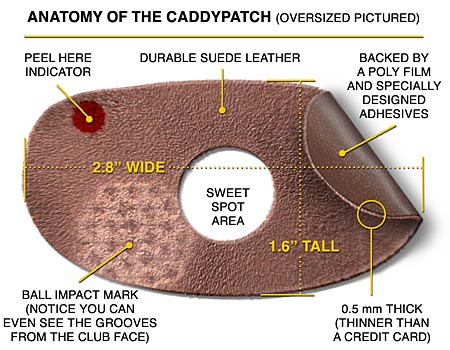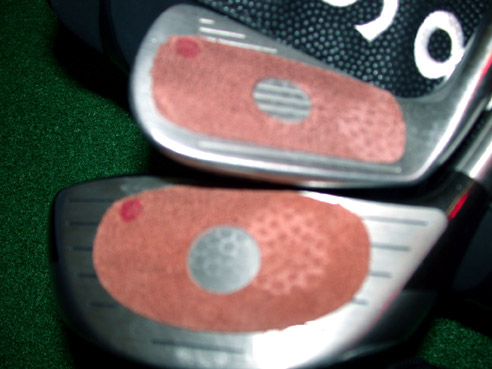![]() Hey there. Got a second? I’d like to ask you a quick question: How do you tell where your club hit the ball on a mis-hit?
Hey there. Got a second? I’d like to ask you a quick question: How do you tell where your club hit the ball on a mis-hit?
If you’re anything like I was a little over a year ago, your answer is probably some variation of “Look for the sky mark.” But, as you play and improve, you’ll eventually have a few lessons and the pro will pull out those little pieces of paper.
You put them on your club, you hit a few shots to see where you’re hitting the ball on your clubface, and then you throw them away. The little papers work, but who wants to mess with peeling stickers every two or three shots? Besides, they sure are expensive, aren’t they?
Enter the CaddyPatch.
I’ve spent a few weeks playing around with the CaddyPatch, and the idea is sound, the product is good, and the results speak for themselves.
The Facts
The CaddyPatch is a thin piece of suede leather with adhesive on the back. A small hole allows for sweet spot contact, and a spot of thicker leather allows you to peel the CaddyPatch off of your club when you’re done. The card the CaddyPatch comes on also serves as a storage card and also features a built-in velcro-like brush.

The CaddyPatch is designed to replace the impact papers that seemed like great technology in the 1990s. Unlike their paper counterparts, the CaddyPatch is extremely durable and can 300 to 500 impacts with proper care. When placed on the face of your club while striking the ball, the ball compacts the suede’s nap and leaves an impression. After a shot, you examine the CaddyPatch and look for the tell-tale mark, then you comb the mark away with the velcro brush.
After a few shots, the process becomes second nature. Hit the shot, think “a bit on the toe” to yourself, check with the CaddyPatch, brush, and go.
Good Stuff!
The CaddyPatch is an economically feasible replacement for standard impact papers. Because they’re suede, they’re far more durable than the impact papers and abundantly reusable. The manufacturer even has a quick tip or two for prolonging the life of your CaddyPatch.
The marks your ball leaves on the CaddyPatch are distinct and easy to recognize. Like impact papers, having the knowledge of both where you hit the ball on the clubface and how consistently you hit the ball gives you the opportunity to improve your swing.
Those worried that a CaddyPatch is going to affect their shots need not worry too much. The CaddyPatch softens impact (and takes away a little distance), but it’s not terribly noticeable. After all, nobody hits range balls the proper distance anyway, and shots hit on the sweet spot still travel the proper distance due to the hole in the CaddyPatch!
The marks the CaddyPatch leaves are easy to see. Here are two intentionally (I promise!) mishit shots. Though my camera’s macro mode didn’t care to take pictures this close-up, you can clearly see the mark a ball has left on the iron (an intentional shank, beat that!) and again inside on the driver a little:

Well, It Ain’t Perfect
My only complaint? I had to reach for a complaint, but here it is: they’re smaller than I’d like them to be. Perhaps I shouldn’t be missing the impact point by so much, or perhaps my clubs are even bigger than the salesperson lead me to believe.
The other downside? CaddyPatches can’t really be used in wet conditions. If you’re the type that hits the range first thing in the morning, the dew is going to wreak havoc with the CaddyPatches and shorten their life dramatically. Stick with the papers when the grass or balls are wet.
All Told…
When all is said and done, the CaddyPatch is an economical counterpart to the impact tape or papers that typically sell for $16 for 250 inches. You’ll use about 2½ inches for every three swings, so $16 in impact tape is good for 300 swings.
Compare that to the CaddyPatch. You can pick up five CaddyPatches – available for irons, woods, and oversize drivers – for $24. Each lasts 300-500 impacts, so $24 ends up lasting 1500 to 2500 swings. And the more you hit the hole in the middle, the longer they last!
If you’re thinking about getting some impact papers, get a CaddyPatch instead. For the money, they’re a better choice – more durable, reusable and easy to read.

Nice review. Sounds like a neat product. A really cheap alternative is covering practice balls with talcum powder, or chalk. It’s really messy, but if you put the powder in a piece of tupper ware with a lid, give it a couple of shakes, and then hit your pracitce balls, you should be left with a nice mark on your club face and no effect on ball flight.
The product is now available in New Zealand and Australia via tod Company Limited.
The reception has been excellent and your comments are correct that it is “good stuff” for practising down at the driving range.
Thanks
Alec Tod, Auckland, New Zealand
Tried it and it is worthless. Not helpful at all